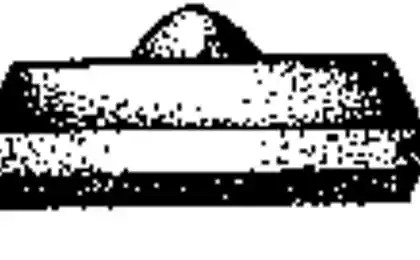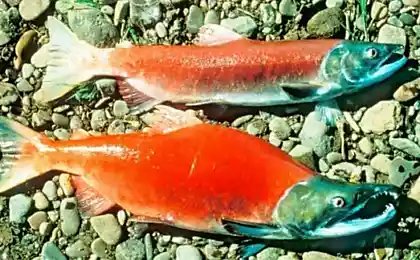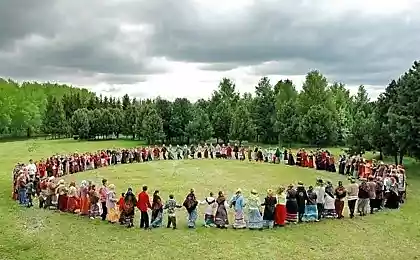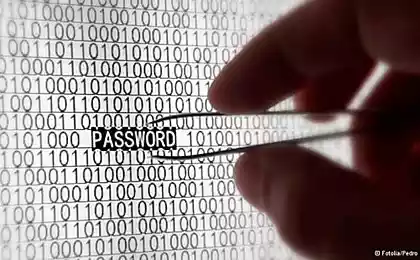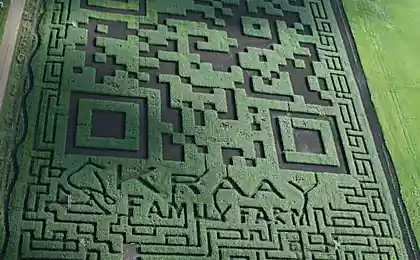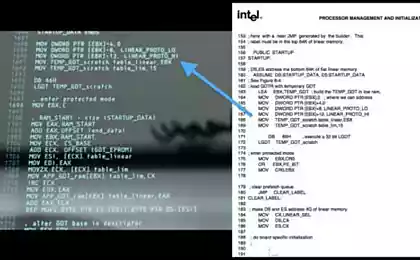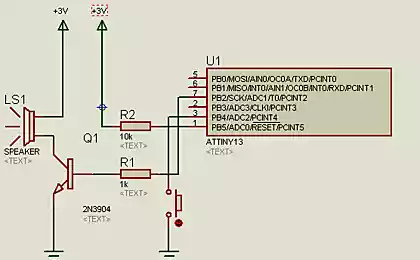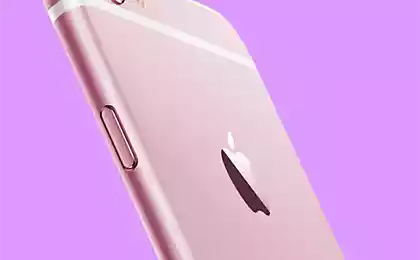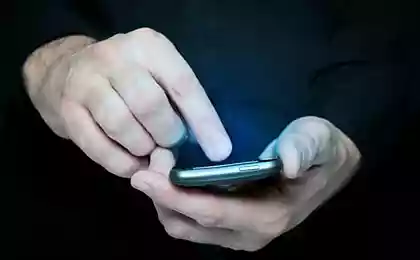857
Code of life
Deoxyribonucleic acid
A lot of pictures, a lot of text!
Of all the chemical constituents of the body, there is one mysterious, known to almost all - DNA (Deoxyribonucleic acid).
Certainly, many have seen is not just the double helix of DNA.
Few people know, but the DNA is very long and very thin. You know how thin? Its width is about 2 nanometers and a length of 2 meters. 2 meters of DNA in each (no one believed) about 100 billion cells in you!
What do you think which one is correct? Here are 3 variants of the DNA helix.

The first - is correct, the second - so looks DNA dried and deformed, and the third - the wrong image.
During the first quarter of the twentieth century, it was believed that the carrier of genetic (hereditary) information is a protein (protein).
The fact that a great variety of proteins, they are terribly varied. This diversity, together with the fact of their presence in the nucleus of eukaryotic cells (all multicellular and some unicellular eukaryotes have a cell nucleus, while the prokaryotes not) pointed to the fact that they are carriers of memory.
DNA seemed too simple to be the bearer of such a huge amount of information. But this theory has not been accepted.
Over time, there were suspicions that the role of DNA is much more important than it seemed. But due to lack of technology, it was impossible to check.
However, in the 1920s, Frederick Griffith, an English physician, bacteriologist during the experiments related to the search for a vaccine against pneumonia (Streptococcus pneumoniae) inadvertently made a great discovery.
Anyone who studies microbiology, knows about the famous "Griffith's experiment." During the experiment, Griffith observed phenomenon "transformation».
Griffith's experiment.
The experiment is as follows:
There are two (2) different strains (bacterial culture) bacterium Streptococcus pneumoniae. The first strain R, a second S.
Bacteria R has an uneven surface, and S bacteria were covered with something like capsules, and they had a smooth surface.
When the mouse is infected by bacteria R, the mouse gets sick, but her body fought the infection. Having infected mouse (another course) bacteria strain S, mouse died during the day. Further, heating the bacteria strain S (dangerous), and killed them all (important point) temperature, worked hard in the mouse. The mouse survived (because the bacteria already dead before an injection).
Last - were taken harmless bacteria R, and S and dangerous dead were inserted into the mouse. The mouse died. By repeating the experiment, it happened over and over again.
You ask how? It was simultaneously inject 2 types of bacteria - Safety R & DEAD BUT dangerous bacteria S. Which of them could kill a mouse?
He took the blood for analysis. The detected bacteria levels were similar to the strain S. Live. These bacteria have strain R, priobretuschie capsule strain S, and thus survived the attack of the immune system.
Their genetic material is mixed with the genetic material of a dead strain of S.
Griffith suggested that the conversion carried out a "transforming factor", wherein R strain was killed by the bacteria strain S.
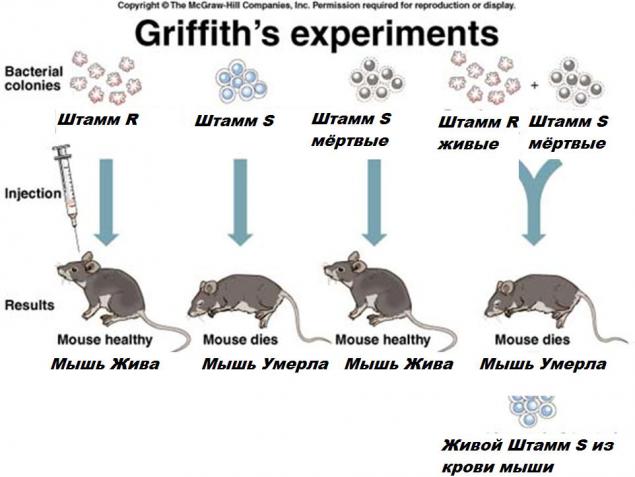
Later, in the 40s a group of researchers headed by Oswald T. Avery tried by process of elimination to solve the issue once and for all, proteins or DNA carry information. They exclude different groups of chemicals that make up bacteria killed S-strain, before they enter into a mouse. Except for a group of different chemicals group isledovateli found that transformation does not occur only in the case of bacteria extract DNA.
Thus was the first time proved its role in our cells.
This work, was published in 1944, but attracted much too little attention, because biologists were not sure whether all the genetic material of bacteria (called a doubt the fact that the bacteria do not have a cell nucleus).
In 1952, Alfred D. Hershey and Martha Chase performed experiments fully confirmed that DNA are the carriers of information.
Their experiment was as follows:
Bacteriophage T2 (the virus that attacks bacteria) that normally attacks bacteria E. coli (E. coli).
T2 Bacteriophage attacking a bacterium E.Coli
Bacteriophage T2 consists of a "syringe" shell of proteins and imprisoned in their DNA. Attack bacterium pristykovyvayas the membrane bacteria and sticking to it the genetic material that more bacteria recognizes as its own and be used like any other piece of DNA, but in this case it is instructed to his death - an instruction for the production of multiple copies of the DNA virus, and protein membranes, which subsequently tear it from the inside and flock to other bacteria.
The essence of the experiment is to mark proteins and DNA virus special radioactive isotope, and then give them to infect bacteria, then take the bacteria and unleash them on the centrifuge (the way of laboratory centrifuges - Now there are those who can create for the objects of the experiment forces of 2000 G, and more robust design is not it?). Untwist bacterial, subjecting them to a large G, all that remains on the outside and not the genetic material (either DNA or protein) is disconnected from the bacteria, and then it will be easy to calculate the result, which, as you probably already realized, was the DNA. This experiment put an end to disputes about the nature of genetic material.
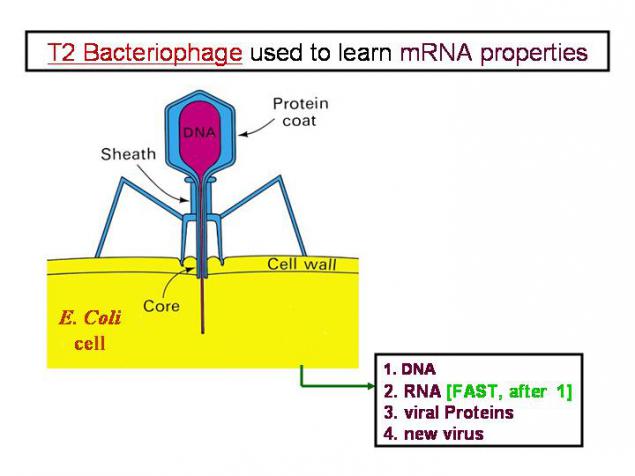
But at that time, it was completely unknown what it looks like DNA.
There is a method in chemistry - «X-ray Cristallography» - ray kristallokrafiya. Open crystallized, irradiated, produces images.
Above the image of DNA worked Rosalind Franklin, the British biophysicist (or rather "biofizichka»).
Rosalind Franklin and DNA picture crystallized
The picture shows two polynucleotide antiparralelno reaching each other.

Her work, was published in 1953.
The journal Nature for April 25, 1953 article by Dr. Rosalind.
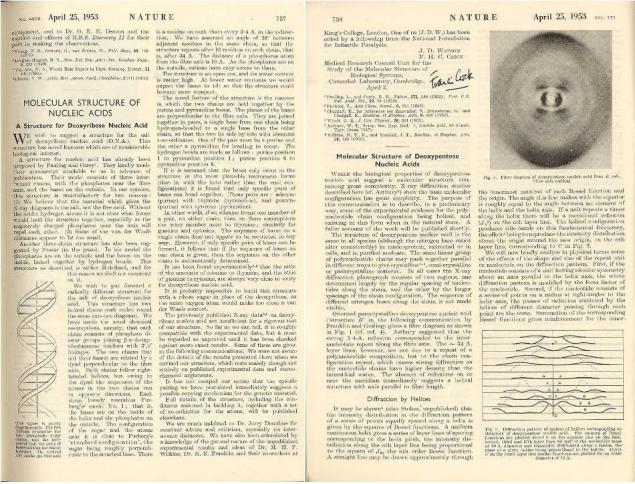
American biologists Francis Crick and James D. Watson, using material from this article, have confirmed their theory that DNA is a double helix.
Photo Francis Crick and James D. Watson. (note the model of DNA between them)
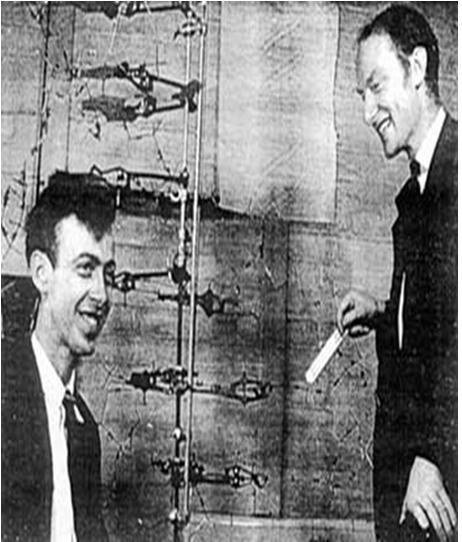
They were the people who discovered us all the familiar double helix. DNA
Now let's move on to the DNA itself.
DNA appears in expanded form as a ladder in the children's drawings.
Two sticks with perekladinkami.
As shown in the figure, it consists of two parts, each of which starts at the number 3 and ending in 5 ...
If divided in half along the ladder, we get 2 chains of nucleotides. Each of the nucleotides - "halves step" consists of three parts - a sugar, a phosphate group (both of which are part of the structure as a whole) and the coding parts - a nitrogenous base. There are 4 types of nitrogenous bases, abbreviated - ATG C.
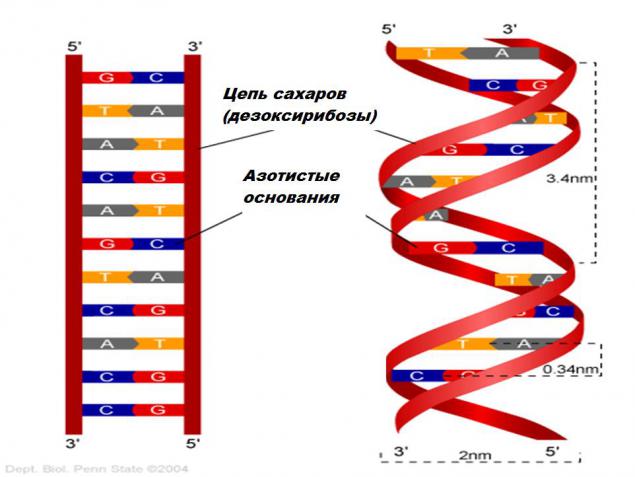
Nitrogenous bases.
As you can see, there are 2 antiparalelnye (Parallel, but opposite to each other) chains. Unites them phosphates (orange) and the circuit itself consists of sugars (blue).
There are 4 letters code - A, G, T, C (short for Adenine, Guanine, Cytosine, Thymine).
Their peculiarity is that they can be united only in pairs AT and CG.
This feature ensures that the code is duplicated in each of the double chain DNA.
In the sequence of nitrogenous bases coded recipe for proteins and enzymes that make up the build and service all of our cells.
Everyone knows the adrenaline! This hormone is called scientifically Epinephrine.
And one of its variants, code that is contained information about the construction of this enzyme. Each of the letters - a nitrogenous base. Each letter will be translated into the amino acid. And the chain of amino acids will be minimized in the enzyme. Data from the World Bank gene (www.ncbi.nih.gov/Genbank/), a variant of the code of human DNA epinephrine.
1 cggcctgcgt ccgccaccgg aagcgccctc ctaatccccg cagcgccacc gccattgccg
61 ccatcgtcgt ggggcttctg gggcagctag ggctgcccgc cgcgctgcct gcgccggacc
121 ggggcgggtc cagtcccggg cgggccgtcg cgggagagaa ataacatctg ctttgctgcc
181 gagctcagag gagaccccag acccctcccg cagccagagg gctggagcct gctcagaggt
241 gctttgaaga tgccggaggc cccgcctctg ctgttggcag ctgtgttgct gggcctggtg
301 ctgctggtgg tgctgctgct gcttctgagg cactggggct ggggcctgtg ccttatcggc
361 tggaacgagt tcatcctgca gcccatccac aacctgctca tgggtgacac caaggagcag
421 cgcatcctga accacgtgct gcagcatgcg gagcccggga acgcacagag cgtgctggag
481 gccattgaca cctactgcga gcagaaggag tgggccatga acgtgggcga caagaaaggc
541 aagatcgtgg acgccgtgat tcaggagcac cagccctccg tgctgctgga gctgggggcc
601 tactgtggct actcagctgt gcgcatggcc cgcctgctgt caccaggggc gaggctcatc
661 accatcgaga tcaaccccga ctgtgccgcc atcacccagc ggatggtgga tttcgctggc
721 gtgaaggaca aggtcaccct tgtggttgga gcgtcccagg acatcatccc ccagctgaag
781 aagaagtatg atgtggacac actggacatg gtcttcctcg accactggaa ggaccggtac
841 ctgccggaca cgcttctctt ggaggaatgt ggcctgctgc ggaaggggac agtgctactg
901 gctgacaacg tgatctgccc aggtgcgcca gacttcctag cacacgtgcg cgggagcagc
961 tgctttgagt gcacacacta ccaatcgttc ctggaataca gggaggtggt ggacggcctg
1021 gagaaggcca tctacaaggg cccaggcagc gaagcagggc cctgactgcc cccccggccc
1081 ccctctcggg ctctctcacc cagcctggta ctgaaggtgc cagacgtgct cctgctgacc
1141 ttctgcggct ccgggctgtg tcctaaatgc aaagcacacc tcggccgagg cctgcgccct
1201 gacatgctaa cctctctgaa ctgcaacact ggattgttct tttttaagac tcaatcatga
1261 cttctttact aacactggct agctatatta tcttatatac taatatcatg ttttaaaaat
1321 ataaaataga aattaagaat ctaaatattt agatataact cgacttagta catccttctc
1381 aactgccatt cccctgctgc ccttgacttg ggcaccaaac attcaaagct ccccttgacg
1441 gacgctaacg ctaagggcgg ggcccctagc tggctgggtt ctgggtggca cgcctggccc
1501 actggcctcc cagccacagt ggtgcagagg tcagccctcc tgcagctagg ccaggggcac
1561 ctgttagccc catggggacg actgccggcc tgggaaacga agaggagtca gccagcattc
1621 acacctttct gaccaagcag gcgctgggga caggtggacc ccgcagcagc accagcccct
1681 ctgggcccca tgtggcacag agtggaagca tctccttccc tactccccac tgggccttgc
1741 ttacagaaga ggcaatggct cagaccagct cccgcatccc tgtagttgcc tccctggccc
1801 atgagtgagg atgcagtgct ggtttctgcc cacctacacc tagagctgtc cccatctcct
1861 ccaaggggtc agactgctag ccacctcaga ggctccaagg gcccagttcc caggcccagg
1921 acaggaatca accctgtgct agctgagttc acctgcaccg agaccagccc ctagccaaga
1981 ttctactcct gggctcaagg cctggctagc ccccagccag cccactccta tggatagaca
2041 gaccagtgag cccaagtgga caagtttggg gccacccagg gaccagaaac agagcctctg
2101 caggacacag cagatgggca cctgggacca cctccaccca gggccctgcc ccagacgcgc
2161 agaggcccga cacaagggag aagccagcca cttgtgccag acctgagtgg cagaaagcaa
2221 aaagttcctt tgctgcttta atttttaaat tttcttacaa aaatttaggt gtttaccaat
2281 agtcttattt tggcttattt ttaa
That is what the code looks like. It just like millions of other codes, and proteins and enzymes in your body. This code is the code of life. Look at it - it's a piece of us.
P.S.
I do not know how interesting this topic will be public, but in the case of the good reviews, I would continue the theme - the transfer of the DNA code. About how this recipe is read and executed.
P.P.S.
Materials taken from lectures on molecular biology, image partly lectures and partly from the Internet.
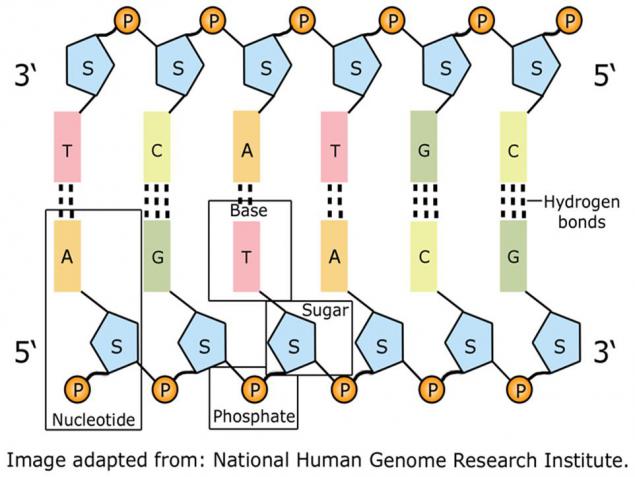
Source:
A lot of pictures, a lot of text!
Of all the chemical constituents of the body, there is one mysterious, known to almost all - DNA (Deoxyribonucleic acid).
Certainly, many have seen is not just the double helix of DNA.
Few people know, but the DNA is very long and very thin. You know how thin? Its width is about 2 nanometers and a length of 2 meters. 2 meters of DNA in each (no one believed) about 100 billion cells in you!
What do you think which one is correct? Here are 3 variants of the DNA helix.

The first - is correct, the second - so looks DNA dried and deformed, and the third - the wrong image.
During the first quarter of the twentieth century, it was believed that the carrier of genetic (hereditary) information is a protein (protein).
The fact that a great variety of proteins, they are terribly varied. This diversity, together with the fact of their presence in the nucleus of eukaryotic cells (all multicellular and some unicellular eukaryotes have a cell nucleus, while the prokaryotes not) pointed to the fact that they are carriers of memory.
DNA seemed too simple to be the bearer of such a huge amount of information. But this theory has not been accepted.
Over time, there were suspicions that the role of DNA is much more important than it seemed. But due to lack of technology, it was impossible to check.
However, in the 1920s, Frederick Griffith, an English physician, bacteriologist during the experiments related to the search for a vaccine against pneumonia (Streptococcus pneumoniae) inadvertently made a great discovery.
Anyone who studies microbiology, knows about the famous "Griffith's experiment." During the experiment, Griffith observed phenomenon "transformation».
Griffith's experiment.
The experiment is as follows:
There are two (2) different strains (bacterial culture) bacterium Streptococcus pneumoniae. The first strain R, a second S.
Bacteria R has an uneven surface, and S bacteria were covered with something like capsules, and they had a smooth surface.
When the mouse is infected by bacteria R, the mouse gets sick, but her body fought the infection. Having infected mouse (another course) bacteria strain S, mouse died during the day. Further, heating the bacteria strain S (dangerous), and killed them all (important point) temperature, worked hard in the mouse. The mouse survived (because the bacteria already dead before an injection).
Last - were taken harmless bacteria R, and S and dangerous dead were inserted into the mouse. The mouse died. By repeating the experiment, it happened over and over again.
You ask how? It was simultaneously inject 2 types of bacteria - Safety R & DEAD BUT dangerous bacteria S. Which of them could kill a mouse?
He took the blood for analysis. The detected bacteria levels were similar to the strain S. Live. These bacteria have strain R, priobretuschie capsule strain S, and thus survived the attack of the immune system.
Their genetic material is mixed with the genetic material of a dead strain of S.
Griffith suggested that the conversion carried out a "transforming factor", wherein R strain was killed by the bacteria strain S.

Later, in the 40s a group of researchers headed by Oswald T. Avery tried by process of elimination to solve the issue once and for all, proteins or DNA carry information. They exclude different groups of chemicals that make up bacteria killed S-strain, before they enter into a mouse. Except for a group of different chemicals group isledovateli found that transformation does not occur only in the case of bacteria extract DNA.
Thus was the first time proved its role in our cells.
This work, was published in 1944, but attracted much too little attention, because biologists were not sure whether all the genetic material of bacteria (called a doubt the fact that the bacteria do not have a cell nucleus).
In 1952, Alfred D. Hershey and Martha Chase performed experiments fully confirmed that DNA are the carriers of information.
Their experiment was as follows:
Bacteriophage T2 (the virus that attacks bacteria) that normally attacks bacteria E. coli (E. coli).
T2 Bacteriophage attacking a bacterium E.Coli
Bacteriophage T2 consists of a "syringe" shell of proteins and imprisoned in their DNA. Attack bacterium pristykovyvayas the membrane bacteria and sticking to it the genetic material that more bacteria recognizes as its own and be used like any other piece of DNA, but in this case it is instructed to his death - an instruction for the production of multiple copies of the DNA virus, and protein membranes, which subsequently tear it from the inside and flock to other bacteria.
The essence of the experiment is to mark proteins and DNA virus special radioactive isotope, and then give them to infect bacteria, then take the bacteria and unleash them on the centrifuge (the way of laboratory centrifuges - Now there are those who can create for the objects of the experiment forces of 2000 G, and more robust design is not it?). Untwist bacterial, subjecting them to a large G, all that remains on the outside and not the genetic material (either DNA or protein) is disconnected from the bacteria, and then it will be easy to calculate the result, which, as you probably already realized, was the DNA. This experiment put an end to disputes about the nature of genetic material.

But at that time, it was completely unknown what it looks like DNA.
There is a method in chemistry - «X-ray Cristallography» - ray kristallokrafiya. Open crystallized, irradiated, produces images.
Above the image of DNA worked Rosalind Franklin, the British biophysicist (or rather "biofizichka»).
Rosalind Franklin and DNA picture crystallized
The picture shows two polynucleotide antiparralelno reaching each other.

Her work, was published in 1953.
The journal Nature for April 25, 1953 article by Dr. Rosalind.

American biologists Francis Crick and James D. Watson, using material from this article, have confirmed their theory that DNA is a double helix.
Photo Francis Crick and James D. Watson. (note the model of DNA between them)

They were the people who discovered us all the familiar double helix. DNA
Now let's move on to the DNA itself.
DNA appears in expanded form as a ladder in the children's drawings.
Two sticks with perekladinkami.
As shown in the figure, it consists of two parts, each of which starts at the number 3 and ending in 5 ...
If divided in half along the ladder, we get 2 chains of nucleotides. Each of the nucleotides - "halves step" consists of three parts - a sugar, a phosphate group (both of which are part of the structure as a whole) and the coding parts - a nitrogenous base. There are 4 types of nitrogenous bases, abbreviated - ATG C.

Nitrogenous bases.
As you can see, there are 2 antiparalelnye (Parallel, but opposite to each other) chains. Unites them phosphates (orange) and the circuit itself consists of sugars (blue).
There are 4 letters code - A, G, T, C (short for Adenine, Guanine, Cytosine, Thymine).
Their peculiarity is that they can be united only in pairs AT and CG.
This feature ensures that the code is duplicated in each of the double chain DNA.
In the sequence of nitrogenous bases coded recipe for proteins and enzymes that make up the build and service all of our cells.
Everyone knows the adrenaline! This hormone is called scientifically Epinephrine.
And one of its variants, code that is contained information about the construction of this enzyme. Each of the letters - a nitrogenous base. Each letter will be translated into the amino acid. And the chain of amino acids will be minimized in the enzyme. Data from the World Bank gene (www.ncbi.nih.gov/Genbank/), a variant of the code of human DNA epinephrine.
1 cggcctgcgt ccgccaccgg aagcgccctc ctaatccccg cagcgccacc gccattgccg
61 ccatcgtcgt ggggcttctg gggcagctag ggctgcccgc cgcgctgcct gcgccggacc
121 ggggcgggtc cagtcccggg cgggccgtcg cgggagagaa ataacatctg ctttgctgcc
181 gagctcagag gagaccccag acccctcccg cagccagagg gctggagcct gctcagaggt
241 gctttgaaga tgccggaggc cccgcctctg ctgttggcag ctgtgttgct gggcctggtg
301 ctgctggtgg tgctgctgct gcttctgagg cactggggct ggggcctgtg ccttatcggc
361 tggaacgagt tcatcctgca gcccatccac aacctgctca tgggtgacac caaggagcag
421 cgcatcctga accacgtgct gcagcatgcg gagcccggga acgcacagag cgtgctggag
481 gccattgaca cctactgcga gcagaaggag tgggccatga acgtgggcga caagaaaggc
541 aagatcgtgg acgccgtgat tcaggagcac cagccctccg tgctgctgga gctgggggcc
601 tactgtggct actcagctgt gcgcatggcc cgcctgctgt caccaggggc gaggctcatc
661 accatcgaga tcaaccccga ctgtgccgcc atcacccagc ggatggtgga tttcgctggc
721 gtgaaggaca aggtcaccct tgtggttgga gcgtcccagg acatcatccc ccagctgaag
781 aagaagtatg atgtggacac actggacatg gtcttcctcg accactggaa ggaccggtac
841 ctgccggaca cgcttctctt ggaggaatgt ggcctgctgc ggaaggggac agtgctactg
901 gctgacaacg tgatctgccc aggtgcgcca gacttcctag cacacgtgcg cgggagcagc
961 tgctttgagt gcacacacta ccaatcgttc ctggaataca gggaggtggt ggacggcctg
1021 gagaaggcca tctacaaggg cccaggcagc gaagcagggc cctgactgcc cccccggccc
1081 ccctctcggg ctctctcacc cagcctggta ctgaaggtgc cagacgtgct cctgctgacc
1141 ttctgcggct ccgggctgtg tcctaaatgc aaagcacacc tcggccgagg cctgcgccct
1201 gacatgctaa cctctctgaa ctgcaacact ggattgttct tttttaagac tcaatcatga
1261 cttctttact aacactggct agctatatta tcttatatac taatatcatg ttttaaaaat
1321 ataaaataga aattaagaat ctaaatattt agatataact cgacttagta catccttctc
1381 aactgccatt cccctgctgc ccttgacttg ggcaccaaac attcaaagct ccccttgacg
1441 gacgctaacg ctaagggcgg ggcccctagc tggctgggtt ctgggtggca cgcctggccc
1501 actggcctcc cagccacagt ggtgcagagg tcagccctcc tgcagctagg ccaggggcac
1561 ctgttagccc catggggacg actgccggcc tgggaaacga agaggagtca gccagcattc
1621 acacctttct gaccaagcag gcgctgggga caggtggacc ccgcagcagc accagcccct
1681 ctgggcccca tgtggcacag agtggaagca tctccttccc tactccccac tgggccttgc
1741 ttacagaaga ggcaatggct cagaccagct cccgcatccc tgtagttgcc tccctggccc
1801 atgagtgagg atgcagtgct ggtttctgcc cacctacacc tagagctgtc cccatctcct
1861 ccaaggggtc agactgctag ccacctcaga ggctccaagg gcccagttcc caggcccagg
1921 acaggaatca accctgtgct agctgagttc acctgcaccg agaccagccc ctagccaaga
1981 ttctactcct gggctcaagg cctggctagc ccccagccag cccactccta tggatagaca
2041 gaccagtgag cccaagtgga caagtttggg gccacccagg gaccagaaac agagcctctg
2101 caggacacag cagatgggca cctgggacca cctccaccca gggccctgcc ccagacgcgc
2161 agaggcccga cacaagggag aagccagcca cttgtgccag acctgagtgg cagaaagcaa
2221 aaagttcctt tgctgcttta atttttaaat tttcttacaa aaatttaggt gtttaccaat
2281 agtcttattt tggcttattt ttaa
That is what the code looks like. It just like millions of other codes, and proteins and enzymes in your body. This code is the code of life. Look at it - it's a piece of us.
P.S.
I do not know how interesting this topic will be public, but in the case of the good reviews, I would continue the theme - the transfer of the DNA code. About how this recipe is read and executed.
P.P.S.
Materials taken from lectures on molecular biology, image partly lectures and partly from the Internet.

Source:
